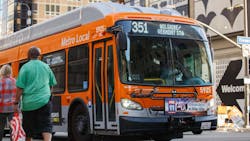L.A. Metro releases frequent bus service plan for NextGen Bus Plan
The Los Angeles County Metropolitan Transportation Authority (Metro) has released a draft of its NextGen Bus Plan, which would improve the frequency of buses across the system.
Under the draft NextGen Bus Plan there would be much more frequent bus service on most routes, shorter waits for buses and more reliable service. If the new plan is adopted:
- Buses would arrive every five to 10 minutes for 83 percent of current riders compared to 49 percent today.
- The number of bus lines running every five to 10 minutes on weekdays would jump from 16 to 29 and from two to 14 on weekends.
- The number of Los Angeles County residents who could walk to bus lines running every five to 10 minutes would more than double from 900,000 currently to almost 2.2 million.
The draft plan aims to change current bus service to meet the demands of most L.A. Metro riders. To do this, the plan consolidates routes on streets with the highest demand and combines L.A. Metro local and most Rapid lines with the overall number of stops reduced. Buses would stop fewer times than a local bus but a few more than a rapid bus. The result would be a faster door-to-door trip for all riders, whether they currently take L.A. Metro local or Rapid routes.
Some bus service in underutilized areas would also be shifted to other bus agencies in L.A. County, such as areas where L.A. Metro bus service currently overlaps with other providers. In areas with bus service that is perpetually under-used or areas that the public have said are difficult to serve with full size buses on fixed routes, L.A. Metro will explore other ways to help people get around, including the agency’s future on-demand shuttle service.
L.A. Metro says its bus system is the second busiest in the United States. The study for NextGen Bus Plan began in 2018 and is the first major makeover of the system in more than 25 years. The study is a direct response to changing travel patterns in L.A. County and a decline in L.A. Metro bus ridership from 1.14 million average weekday boardings in 2013 to 878,862 in 2019.
The L.A. Metro Board of Directors is scheduled to vote at its meeting on Jan. 23 to formally release the NextGen plan for public review. If that happens, public workshops will be held in February and March to be followed by meetings with stakeholders this spring. Public hearings would begin in June and would be considered by L.A. Metro Service Councils in August and the L.A. Metro Board in September.
Later this month, L.A. Metro will also be releasing route-by-route changes and online tools that will better visualize what bus rides would be like under the draft plan.
If approved, the rollout of the new bus system would take place in three phases that coincide with L.A. Metro’s twice-yearly bus service updates. The first wave of changes would begin in December 2020, continue in June 2021 and be completed in December 2021.
Metro staff are also recommending that the L.A. Metro Board adopt a “Transit First” approach that would include capital projects to speed up buses (bus lanes and traffic signal priority, for example), make bus stops more comfortable, expand all-door boarding and add even more frequent service, among other improvements.
Over the last two years as part of its NextGen Bus Study, L.A. Metro has been conducting market research and analyzing local travel data. L.A. Metro has also held 260 stakeholder and community meetings, conducted on-board surveys of bus riders and held 20 interactive public workshops.
What L.A. Metro learned was:
- The public wants more frequent service to reduce often long and unpredictable wait times at bus stops.
- There is significant unmet demand for short rides of one to five miles from midday through the evening hours and on weekends.
- Bus routes on the 44 busiest corridors in L.A. County carry over 80 percent of the L.A. Metro bus system’s riders.
A long-standing criticism of the L.A. Metro bus system has been that it relies too much on legacy lines and that the agency has been reluctant to shed under-performing routes and bulk up service where it is used the most. The NextGen plan seeks, in short, to remedy that by putting service in the places L.A. Metro thinks current and future riders will use it the most.
